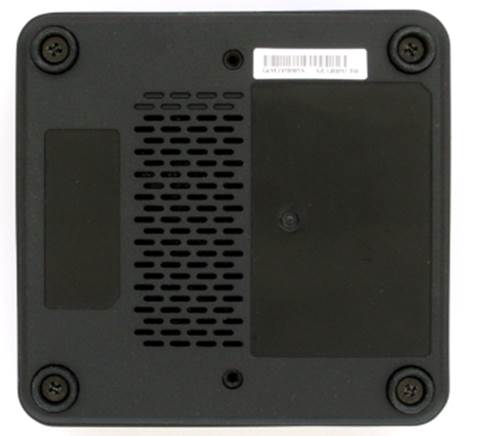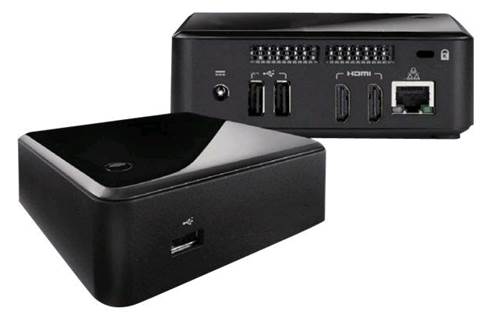We know Intel mainly as a manufacturer of
processors, mainboards and SSDs. However, NUC is a mostly complete computing
system with not only a mainboard and a CPU plus extra controllers, but also a
system case. In other words, this is a classical bare system, in which the user
must add system memory, disk drive and an extendable card if necessary. Of
course, Intel NUC system cases are not manufactured by Intel yet ordered from
contractors. Nonetheless, it’s no doubt that company engineers monitor the
entire process closely, thus the quality of the NUC system case won’t let you
down.

The
system’s design is quite simple
The design of this system case is quite
simple. The skeleton holding the computer system tightly is a black anodized
frame made of 2mm thick steel. It is veiled with plastic panels at the top and
bottom reinforced with internal metal plates. The bottom panel owns four rubber
feet and vent holes.

The
bottom panel
The top panel is a purely decor. It incorporates
a status LED (for storage drive) and a Power On button plus a built-in diode
inside. The top panel’s surface is negatively glossy and in our specific sample
it also looks black, just like other parts of the case.

The
top panel
Though, besides the DC3217IYE model
discussed, Intel also offers a DC3217BY model featuring beautiful the front
panel colored burgundy.
Of course, I would like to interest you with
the Intel NUC system’s size first, which is difficult to described fully as NUC
is so tiny that it couldn’t be associated with a completely-functional computer
system. Plus this isn’t because the black color makes anything look sleeker. The
Intel NUC’s dimension, 117x112x39mm, are more common for things like an optical
drive, that’s why your first impression sees this is a toy computer system, unlike
a real one.

Intel
NUC’s dimension – 117x112x39mm
However, we are people of the old days, and
we have been already familiar with Zotac ZBOX Nano XS computer with comparable
dimensions before, thus we got much calmer this time. Additionally, I have to
admit that the Zotac system case seemed a bit more elegant due to contrasting
colors and soft glow in the front panel. Intel’s design is not seductive. NUC
looks violent and even crude, if we could only use such an attribute for a
system case of this size. However, NUC will look wonderful not only in the common
office setup, but also in a living-room environment. Moreover, the tiny size
will make it easy to hide. In other words, the appearance doesn’t concern much.
All connectors for external peripheral
devices were moved to the side panels. The DC3217IYE model discussed doesn’t
have anything on left or right sides, but one USB2.0 port on the front panel,
and two USB2.0 ports, a Gigabit network port, two HDMI-Ins and a power out on
the back panel. There is also a metal grid on the NUC’s back, covering the cooling
system’s outlets.

Connectors
for external peripheral devices and side panel
It’s not really much. But the fact is
undeniable: Intel not only didn’t ignore analog and digital audio ports but
also didn’t equip the future’s system with any promising USB3.0 ports. The matter
with the sound ports can be easily solved by using HDMI port for sound output.
However, the missing USB3.0 is likely Intel’s result of preferring the new
Thunderbolt interface, which is implemented into the NUC DC3217BY model. Though,
this particular DC3217IYE mini-system didn’t support Thunderbolt as well as USB3.0.
This is a bit disappointing, meaning that this Intel NUC system doesn’t support
any hi-speed interfaces, which doesn’t agree well with the entire “the future
computer” concept.
However, since the peripheral interface in
Intel NUC DC3217IYE is just USB2.0, it is a shame that there are only three
ports. Two external ports will likely be taken by the mouse and keyboard, thus
there will be only one port left for daily needs. So it means that NUC users
will mostly have to resort to a USB hub. Fortunately, many contemporary
monitors can compensate for the lack of USB ports since many of them also provide
this additional functionality.
The system case can be integrated into the
workspace in two different ways. It can be used as a traditional desktop
system, though it may be quite hard to notice on a desk under a heap of papers,
for instance. Or it may be hung behind the monitor, for example, with the help
of an accompanied VESA mounting kit.
NUC is powered via a small notebook whose
type features 19V external power supply unit with 65W capacity. Our particular
sample came with such a unit made by FSP Group.

Accessories
This kind of Power supply unit is quite
common in netbooks where we have seen them so many times before. Therefore, it
is fair to say that Intel NUC has all the external features of a common nettop.
Yet, this is only true until you remove the top panel.